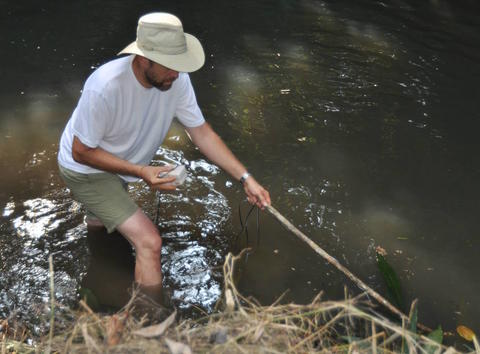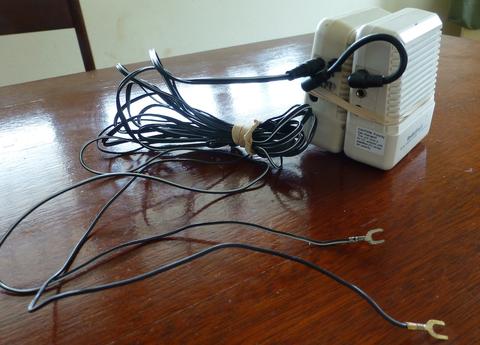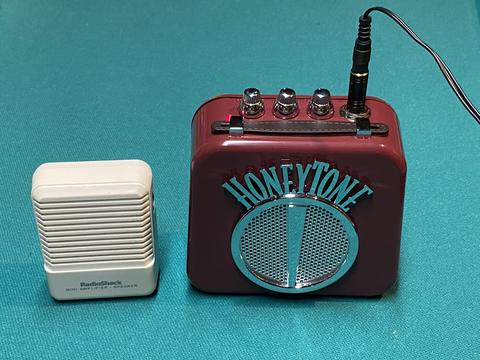Locating and capturing weakly electric fishes (African mormyroids and South American gymnotiforms) in the field is made substantially easier by the use of a hand-held, battery operated amplifier attached to an electrode lowered or cast into the water. The amplifier converts the electric impulses of the fish into audio, allowing the user to determine the presence, proximity and approximate number of individuals within one to several meters from the electrode, depending on the size of the fish. Once you're familiar with what species are found in a particular habitat, you can also, sometimes, infer the species identity of a fish by the sound. We refer to an amplifier and electrode used for this purpose in the field as a "fish finder."
I am frequently asked if there is an affordable, commercially available amplifier suitable for field use as a fish finder. The answer is basically no unless you get creative (which I'll show you how to do).

The the best commercially available not-so-affordable fish finder is the rugged, rechargeable battery-powered CWE BMA-200. With its adjustable gain and high- and low-pass filters it is excellently suited for for use a fish finder (its legs can be folded down and a shoulder strap attached) and as a benchtop amplifier from which to make low-noise DC and AC-coupled EOD recordings. However, it is not cheap (~$1000). Plans for a similar amplifier that can be used both to find fishes in the field and record them in the laboratory were published by Wells and Crampton (2006). To find mormyrids in the field, I often use an amplifier I assembled myself based on a circuit designed years ago by the late Walter Heiligenberg. While a satisfying exercise for the electronics hobbyist, assembling such a device is not a realistic option for most people.
Don't worry, I have a solution for you. The inexpensive, 9-volt battery-powered, mini amplified speaker that Radio Shack has sold since the 1970s (catalog no. 277-1008) is a simple one-stage audio amplifier well suited to many purposes. It is great for demonstrating the electrical impulses of mormyrid or gymnotiform fishes within an aquarium, but it has insufficient gain to locate fishes in the field. Individuals more than a few centimeters away will typically not be audible through its speaker. However, hooking two of these puppies together in series gives you the gain you need. This unit has a 1/8" (3.5 mm) mono input jack as well as an identical output jack just below it. By means of a short cable (preferably 6" or less) with two male 1/8" (3.5 mm) plugs at each end (these can be "TS" mono plugs or "TRS" stereo plugs), two of these amplified speakers can be daisy-chained, with the output from the first going into the input of the second. (The speaker is disabled when a plug is inserted into the output jack of the amplifier.) In this way, the first amplifier serves as a preamp for the second and by careful adjustment of the volume control on the two units (which may be bound together with rubber bands or velcro) one can obtain very good amplification of even very weak signals. I find two daisy-chained Radio Shack 277-1008s are as sensitive as my custom-built amplifier, although they produce more "white noise" hiss when operating. This system worked very well for me on a recent trip to Gabon (photo at left).
Speaker wire is all you need for an electrode. Radio Shack sells a 12' (3.6 m), 24-gauge speaker wire with a 1/8" (3.5 mm) plug well suited to this purpose for $4.00, catalog number 42-2454. You can leave the speaker contact U-lugs on the end, or take them off and expose the speaker wire, as you like. Separate the leads by 8-12" (20-30 cm) and attach them to a stick or rod of some sort (again, rubber bands would work well) that can be submerged in the water. Obviously the phono plug goes in the input of amplified speaker to be used as the preamp. No need to get fancy with silver/silver-chloride electrodes: we are only interested in hearing the fish signals, not making DC recordings of them. By maneuvering the stick or wand to which the electrodes are attached and monitoring the amplitude of the signal in the speaker, one can "home in" on a fish or fishes.

In this way, one can have a complete, high-gain fish finder for less than $40, no soldering required.
Don't try to use one of these Radio Shack amplifiers for recording EODs if you care about capturing an undistorted waveform (on the other hand, if you are only interested in capturing the sequence of pulse intervals they may work just fine). I've found that for recording EODs, the pre-amplifier on the digital audio interface I use (an Edirol FA-66) is sufficient to boost the EODs of all but the smallest fish, so I really don't need a recording amplifier that doubles as a fish-finder.
One thing to keep in mind is that the small speaker on the Radio Shack amplified speaker provides very poor reproduction of lower frequencies. Long EODs produced by species such as Campylomormyrus numenius or Paramormyrops gabonensis with low frequency content will be nearly inaudible through the speaker. Headphones with better bass response could be used to hear such fish, although the stated frequency response of the unit is 100 Hz - 10 kHz. To listen to the Radio Shack 277-1008 with stereo headphones through both earpieces, a mono plug to stereo jack would have to be used.
If you live far from the nearest RadioShack store, there is always eBay.
If you give this suggestion a try, let me know how it works for you.
UPDATE 20 JAN 2021:
Since the demise of Radio Shack a few years ago it has become increasingly hard to find the little amplified speakers described above. When you can find them, for instance on eBay, sellers are often asking ridiculous prices. I have been looking for a Radio Shack alternative for some time. I'm happy to report I've found a replacement better than the original: the Danelectro Honeytone N-10 Electric Guitar Mini Amplifier.  Like the Radio Shack amplified speaker, it is powered by a 9 volt transistor battery or by an external supply through its power port and has a 3.5 mm headphone jack that disables the speaker when used. Though a good deal larger than the Radio Shack 277-1008, it is still easily held in one hand. You can also affix it to a belt via a metal clip on the back. I have yet to try it in the field, but in my aquarium it provides much more amplification for the EODs of my Campylomormyrus than a single Radio Shack speaker and is equal or better than than two of those daisy chained. It has a volume control, tone control, as well a "drive" control which adjusts amplifier gain. As its intended purpose is as a guitar amplifier, its input jack accepts a 6.35 mm (1/4") phono plug instead of the smaller 3.5 mm plug in the Radio Shack unit, so an adaptor will be needed to accept speaker wire with a smaller mono plug. The back comes off with removal of four screws. Of course the Danelectro would not be suitable for amplifying EODs for the purpose of recording them as undoubtedly the frequency response is far from flat. That said, EODs sound 'clean,' not distorted, and the speaker on this unit is more sensitive to lower frequencies than the smaller one on the Radio Shack, so longer duration EODs are more audible. It comes in several nice colors and will set you back only about $25 in the USA. With one of these you can find mormyrids during the day and rock out with your electric ukulele at night. No wait, if you're someplace with mormyrids nearby, you need to be fishing at night, too! If you try one of these in the field I'd be interested to hear about your experience.
Like the Radio Shack amplified speaker, it is powered by a 9 volt transistor battery or by an external supply through its power port and has a 3.5 mm headphone jack that disables the speaker when used. Though a good deal larger than the Radio Shack 277-1008, it is still easily held in one hand. You can also affix it to a belt via a metal clip on the back. I have yet to try it in the field, but in my aquarium it provides much more amplification for the EODs of my Campylomormyrus than a single Radio Shack speaker and is equal or better than than two of those daisy chained. It has a volume control, tone control, as well a "drive" control which adjusts amplifier gain. As its intended purpose is as a guitar amplifier, its input jack accepts a 6.35 mm (1/4") phono plug instead of the smaller 3.5 mm plug in the Radio Shack unit, so an adaptor will be needed to accept speaker wire with a smaller mono plug. The back comes off with removal of four screws. Of course the Danelectro would not be suitable for amplifying EODs for the purpose of recording them as undoubtedly the frequency response is far from flat. That said, EODs sound 'clean,' not distorted, and the speaker on this unit is more sensitive to lower frequencies than the smaller one on the Radio Shack, so longer duration EODs are more audible. It comes in several nice colors and will set you back only about $25 in the USA. With one of these you can find mormyrids during the day and rock out with your electric ukulele at night. No wait, if you're someplace with mormyrids nearby, you need to be fishing at night, too! If you try one of these in the field I'd be interested to hear about your experience.
